#carnivorous plant species
Text
ok this sounds insane but in 2018 i went to a few carnivorous plant talks at the botany conference in minnesota. i got caught up in conversation with one of the guys there who was a huge nepenthes guy who told me a story about another collector in the pacific northwest who'd been buying poached plants, like a huge amount, and eventually got staked out by the fish and wildlife service and arrested and had all his plants seized and went to prison for it. idk if i ever talked about this on this blog before-- i know i liveblogged a lot from that conference but cant remember what all i posted-- but ive avoided talking about it since then because i was never able to find like, news articles or anything covering it, but behold.... we now have proof it was real, and im like 80% sure this was this guy he was talking about. the raid happened in 2016 and they'd been staking them out since 2013. he had nearly 400 plants and had been sourcing many of them from poachers in indonesia and borneo.
remember folks: poaching happens with plants too! it's a huge problem not only in carnvirous plants (nepenthes especially, which this piece is dedicated to talking about) but also in native plant populations in the US, including native carnivorous plant populations (north and south carolina's venus fly traps, california's darlingtonia, and sarracenia from the east coast), native orchids (historically one of the most poached categories), desert plants/cacti/succulents, and slow-growing woody ornamentals (cycads, for example). never buy bare-root plants off ebay or facebook! your best bet is local nurseries (which usually purchase farm-raised plants that do well in a wide range of conditions, and as a result have a healthy population in the wild) or specialty greenhouses (more expensive, but at least in the case of carnivorous plants offer young plants bred from established adult plants in-house, raised in captivity).
#super sad piece fellas like this shit guts me i cant even stress it enough#stories about nepenthes poaching hit different#there are hundreds of species#some are really common and widespread all over indonesia/china/japan/oceania#and some are like. super hyperadapted to one specific ridge on one specific mountain#theyre still being recorded and stuff because theyve speciated so much#so youll have a plant that has like. a max of 15 adults in the population at any given time. literally a nightmare scenario#AND theyre diaceous (there are male plants and female plants). doesnt seem like a problem until you think about the population dynamics#there not only has to be two plants but the plants have to be a male and a female#and people living there have reason to take them. like the poacher interviewed in this article does it to supplement his income#from working at a horrifying rubber production ordeal to feed his wife and kids#and he says everyone in his village does the same for the same reasons#nightmare!! nightmare!! nightmare horrible nightmare world!!! horrible fucking nightmare!!!!#nepenethes#carnivorous plants#poaching#conservation
11K notes
·
View notes
Text



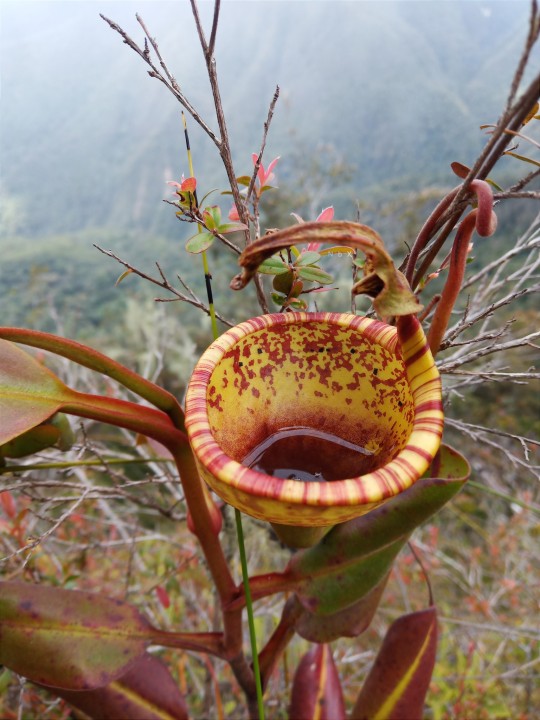
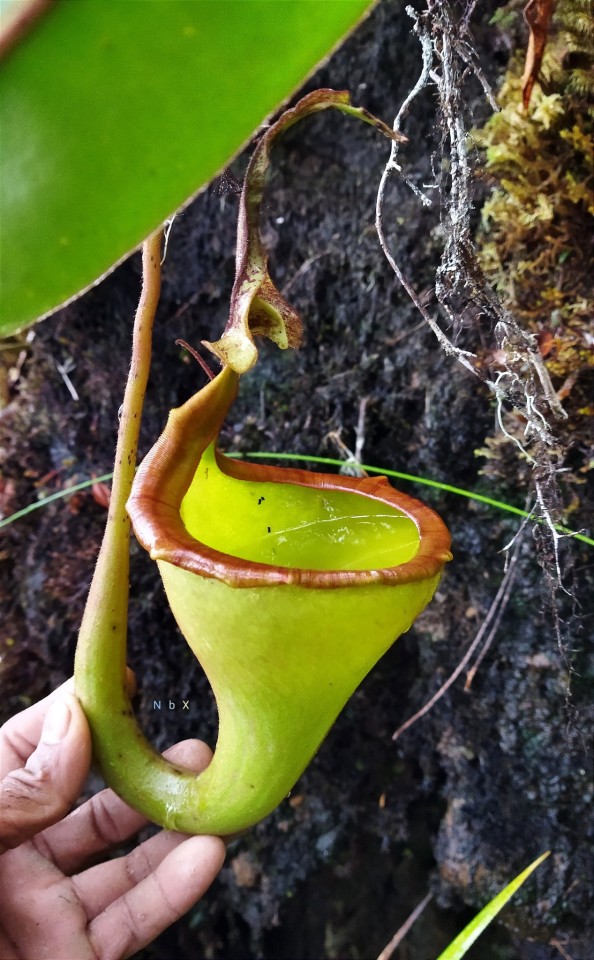
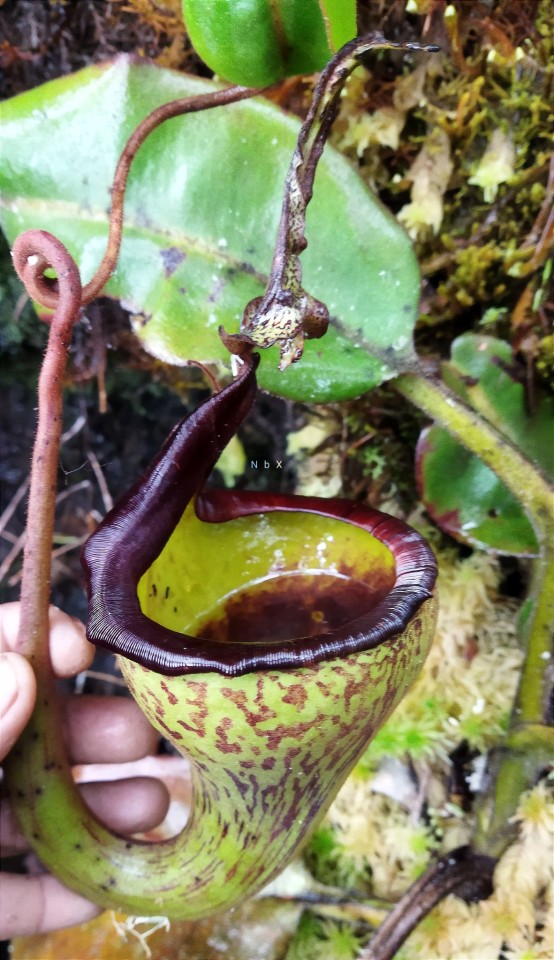

Upper pitcher plants.
Nepenthes Eymae is a colorful plant. very amazing species and beautiful to the eye! Central Sulawesi endemic species. is in the wild in a mossy forest above 1000m.
#plants#nepenthes#carnivorous plants#botany#nepenttheseymae nepenthes eymae pitcherplants carnivoruosplant carnivorousplants species amazingplants nepentheshighland icps
1K notes
·
View notes
Text
Like many species, the Venus flytrap has suffered significant loss of habitat. USFWS has deemed it not worthy of endangered status since there are eight--count 'em, EIGHT--spots where there are robust populations. That isn't so comforting when you consider that the little green dot in the map below is the species' entire wild range:
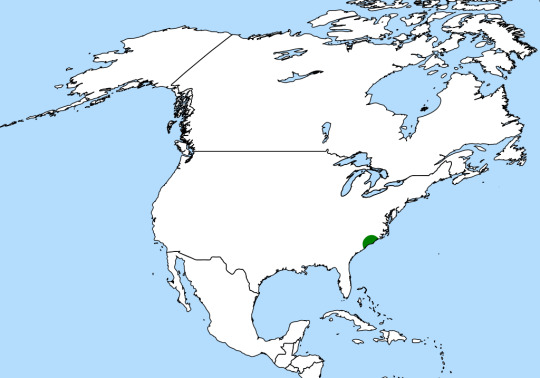
It's pretty sad that we've decided that's the threshold for "This species is okay." Not "this plant has a very limited distribution and a large portion of it has gotten chewed up by development." How many of the wetlands that once inhabited that little green dot still exist today? And of those, how many are healthy enough to support a robust enough population of Venus flytraps to satisfy USFWS? Apparently only eight.
Furthermore, the Supreme Court decision earlier this year that slashed the number of wetlands protected by the Clean Water Act is going to put more of the Venus flytrap's remaining wild range at risk of development. And in spite of the fact that flytraps can be propagated relatively easily in captivity, poaching of wild plants for profit is still rampant. (No, it's not enough for us to have lots of them in captivity, though that at least bodes well for reintroduction efforts.)
Want to help protect these charismatic carnivorous plants? Venus Flytrap Champions and Friends of Plant Conservation are both actively working on monitoring and advocating for wild Venus fkytrap populations.
#Venus fly trap#Venus flytrap#carnivorous plants#plants#botany#gardening#nature#native plants#native species#endangered species#extinction#habitat restoration#conservation#environment#environmentalism
258 notes
·
View notes
Text
Next time someone uses the word "speciesist" to describe the consumption of animal matter or says you can't be an anarchist if you're not vegan because "humans > animals is a hierarchy" I'm going to look them in the eye and say "Why are animals higher in the hierarchy than plants? Why are you kingdomist?" And it's not going to be ironically at all.
#also I can't fucking stand ''vegans'' who think eating animals is morally wrong except it's fine if it's fish. that doesn't count obviously#anyways to me eating other animals is about the LACK of a hierarchy. NOT eating them would be ''humans > animals''#because you are refusing to take part in the cycle of nature and what your body & brain were designed to do for the belief that#you are inherently above nature & other animals and can choose to opt out of it all#not even regarding the fact that I'm not human‚ I'm a carnivorous bird of prey and I eat meat to feel in tune with my species#maybe I could survive biologically on fucking celery and lima beans but not psychologically#my point here is though. that plants are living creatures. when you eat a plant you are still killing a living thing.#I'm sorry but unless you are a photosynthesizer or other kind of autotroph you're going to have to accept that you kill to eat#and if it's about the unethical farming to you look up sometime what we're doing to our topsoil with monocultures#at least that's if the terrible labor practices and exploitation of PEOPLE don't make an impact on your empathy
26 notes
·
View notes
Text
Behold! A new carnivorous plant species!
It hasn't been proven, but supposedly the people who discovered it noticed that insects were trapped in the glandular hairs. All that needs to be proven now is whether or not it is digesting them.
If so, it will also be the first member of Linderniaceae known to be carnivorous. Many members of this family live in or near wetlands on sandy soil, which is already the preferred habitat of many carnivorous plants. So it was probably just a matter of time.
2 notes
·
View notes
Text
Nepenthes Alata x Maxima
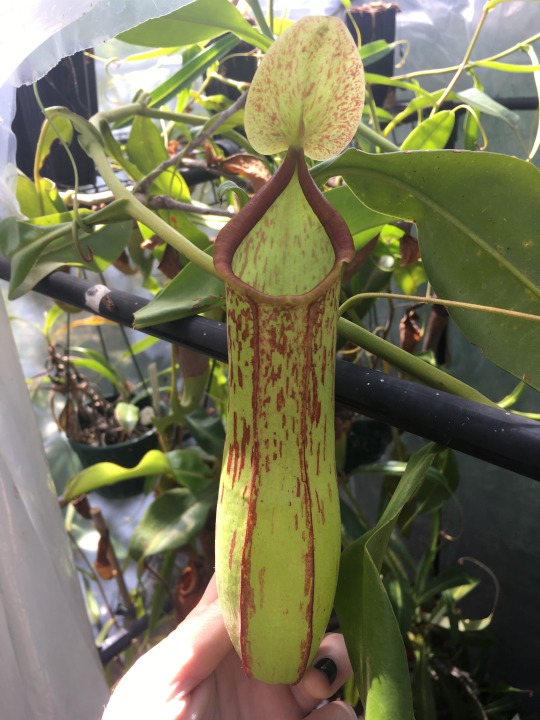
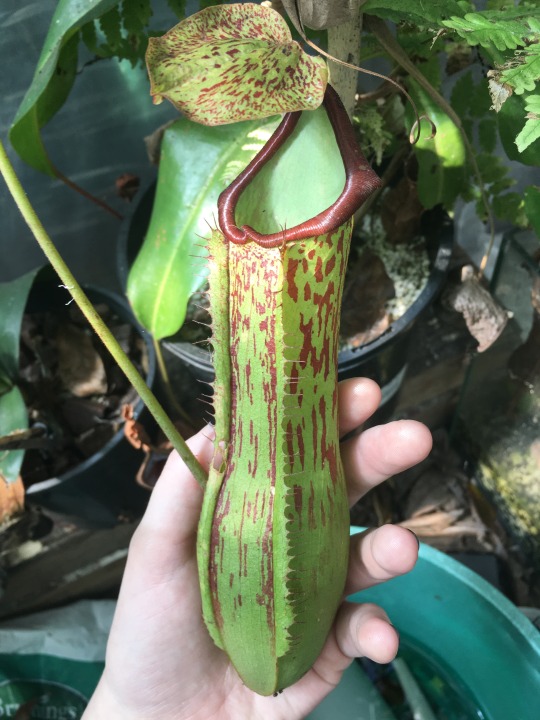

Everyone look at my cool plant, thank U <3
#Is nepenthes alata even a real species#Honestly#i think it doesn't exist#carnivorous plants#carnivourousplant#plantblr#carnivorous plant#carnivorousplants#pitcher plants#pitcher plant#nepenthes#nepenthaceae#plants#gardening
9 notes
·
View notes
Text
i was scared to watch scavenger's reign bc it looked too scawwy for me but i took a risk and watched it and its SO good. titmouse my beloved.
#i love it dearly but the only thing i will say#is damnb those biomes have no business being able to support so many large predators#LIKE I GET THERES LIKE A LOT OF LIFE EVERYWHERE and im not an ecologist so maybe they could im not sure#but babygirl it seems like theres more hunting carnivores than any other species niche other than “”plants“”#also it is an alien planet so who knows but my basic knowledge of ecology makes me feel like thats not super...plausible
5 notes
·
View notes
Note
are kelsi and dr pragma established characters or are they your oc’s ? you write beautifully btw
KAKSKKDKDKDK thank u!!! 🥺💕🧁
I WISH they were from an established series. but alas. they are from my brain. 😔
#they are established in my heart <3#they have lore and a backstory now becuase I haven’t been able to stop thinking about them jsjdjdjd#Dr. Pragma originally studied giant carnivorous plants (an invasive species)#Kelsi is not an official ‘scientist’ and a lot of what she does is /technically/ illegal#I think they share a universe with anise and Jasper#this is information you did not ask for but I love these guys a whole lot so I felt the need to share NANSNNSNDD#mint talks
4 notes
·
View notes
Text
i think my favorite part of making alien ocs is coming up with like. all of the fun different biological features they'd have and why they have them and how that ties into their native environment and how all the different species coevolved :)
#me: ooh ree breathes co2 so there must not be a lot of plants on hir planet so hir species must be mostly carnivorous which means--#my brain: s a g i t t a l c r e s t#wait no a prominent sagittal crest would indicate a diet containing a lot of roughage#silly me ο(=•ω<=)ρ⌒☆
2 notes
·
View notes
Photo

Having recently brought back the landscape of the desert world Alpha Centauri Bb, I figured I'd showcase the few lifeforms that were featured in it (the world itself has more than these of course).
Sand Sailor: These organisms transverse the deserts of their world in small herds in search of plants using the sails on their backs to catch the wind and conserve energy (think strandbeests made by Theo Jansen). The sails also contain algae that convert the sun's rays into sugars that the Sand Sailors use. If the winds are too strong, they fold down their sails and hunker down in the sand until conditions are more favorable. Once they've found some plants, they use their proboscises to bore through the sand and drain fluids from the water filled roots.
Desert Odin: Resembling a reptilian mix of vultures and dragonflies, the Desert Odins are opportunists carnivores who ride on the desert thermals in search of carrion and small animals to feed on. Their most unique adaptation is having a pair of large eyes located on their lower jaw to survey the ground below and a second, smaller pair on the top jaw to detect any intensity in sunlight.
Crown-o-Thorns & Withered Star: Two of the most common plants on Alpha Centauri Bb are the Crown-o-Thorns and the Withered Star. The Crown-o-Thorns, as the name implies, have though, waxy leaves they make them hard for most animals to consume them. The Withered Star have very brittle, sprawling leaves that are able to photosynthesize with the most minimal amount of water possible. Both plants have sprawling root systems that cover a wide area and did deep into the soil, maximizing their ability to collect water wherever there's access to it.
I don't know when I'll depict more species from this world but I do have at least a terrestrial predator and a large organism vaguely in my mind.
As always comments and critiques are welcome.
#Alien#Aliens#alien life#alien species#extraterrestrial#extraterrestrials#extraterrestrial life#speculative biology#speculative#astrobiology#xenology#creature design#animals#plants#desert#sail#carnivore#herbivore#my art#digital art#digital color#Digital Illustration#concept art#Concept Design#alpha centauri
2 notes
·
View notes
Text
Lower pitcher plants.
Nepenthes Eymae is the largest species on the Indonesian island of Sulawesi, within its genus the largest pitcher. which were re-discovered in the wild in 2020. endemic to Central Sulawesi growing in mossy forests above 1000m.

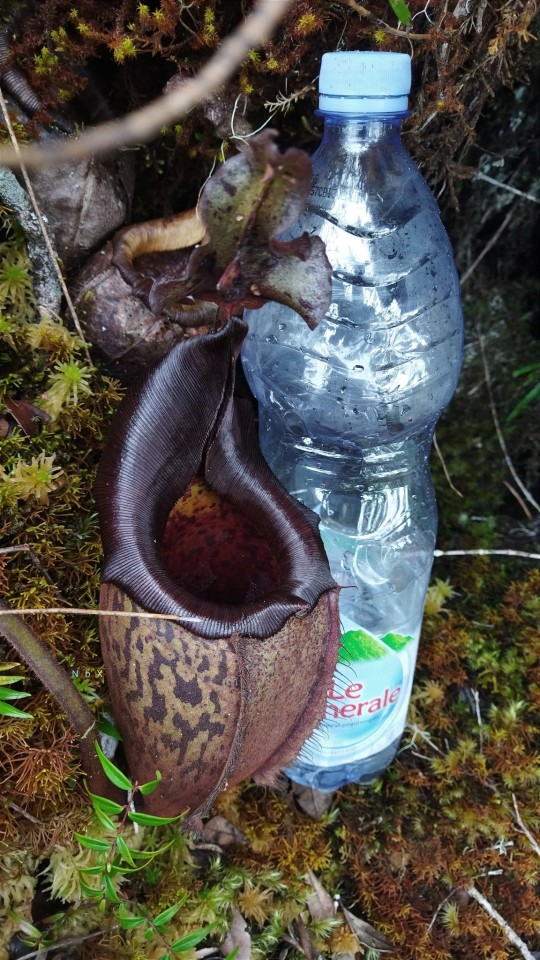

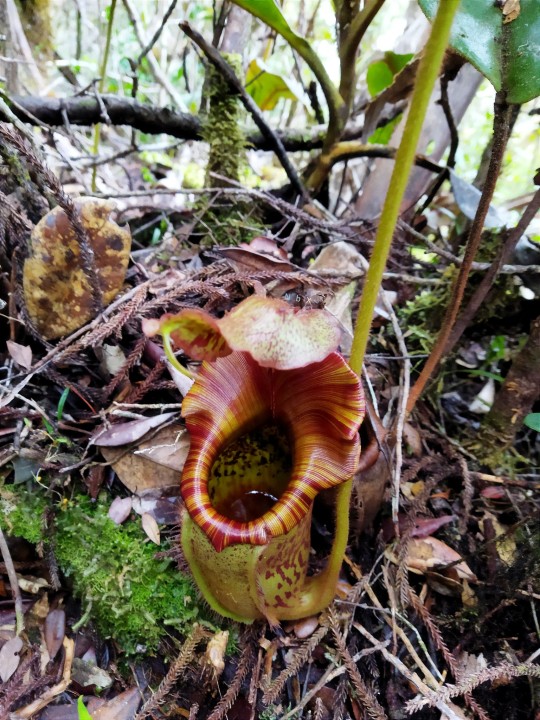


#botany#plants#nepenthes#carnivorous plants#nepenttheseymae nepenthes eymae pitcherplants carnivoruosplant carnivorousplants species amazingplants nepentheshighland icps
26 notes
·
View notes
Text
MINECRAFT PITCHER PLANTS

Apparently pitcher plants were announced a week ago, but I found out about them this morning. As a long time Minecraft player now paid and carnivorous plant enthusiast former collector I never even dreamed about this happening.
As of now they have no function apart from dye, and while it very well could stay as a decorative flower block I think it would be cool if it could be used to collect fireflies. You would have to time your collection since the plant will digest them but it would help in firefly collection (I actually don't know how tedious they are to collect I haven't tried yet). I also think it is interesting that they can be planted on dry farmland right now. Carnivorous plants will die if their soil dries out, so I think they should function similarly to sugar cane and be required to have a water source next to them, maybe 3 blocks away max. They also should not be able to grow with bonemeal and instead die when applied since they evolved to be a carnivore to adapt to nutrient deficient soils.
However, I want to talk about what kind of pitcher plant this is. On Twitter one of the developers mentioned that it was an imaginary plant, but that will not stop me for overanalyzing it. There is clear reference to real pitcher plants and I want to explain them. We will be ignoring the color because no real pitcher is that vibrant or blue, but the shape and structure is really where we can determine the species.
For reference, I will be referring to the plants I talk about as Tropical and North American (split into Trumpet and Open*) pitcher plants, respectively.

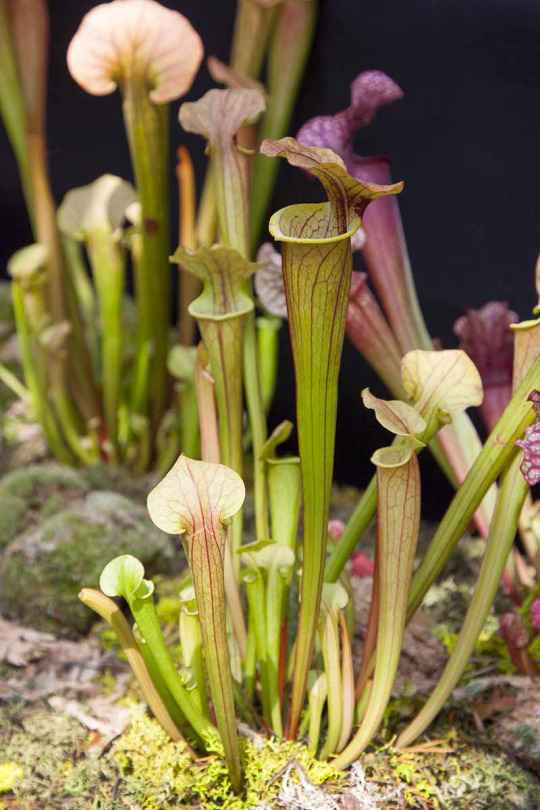
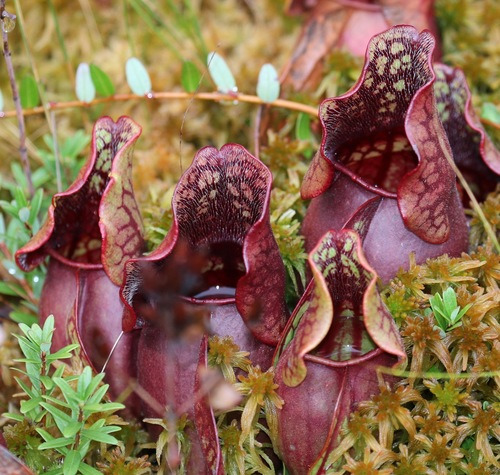
*"Open" is my own term since I believe that they describe them better than "purple" or "northern" pitcher plants, especially for this analysis.
1. Standing Upright
Tropical pitcher plants hang off of the leaf they are produced from while North American pitchers grow up from the ground, supporting themselves in an upright position like many other plants. Based on this structure, this species is based off of the North American varieties.
2. Bulbous Pitcher
Trumpet pitchers have a very long an narrow pitcher, making them perfect for a pitfall trap. Open pitchers on the other hand are much shorter and rounder, filling with water to drown and digest their prey. Even when compared to a majority of Tropical pitchers, the Open pitchers have a much rounder shape while Tropical pitchers still tend to maintain some degree of straightness in their pitchers. The pitcher body is based off of the Open pitcher plant.
3. Covered Leaf Lid
Even though the body is based off of an Open pitcher, the top leaf is covering the trap instead of being open. For Tropical and Trumpet pitchers, this covering is used to prevent water from building up in the trap, however as mentioned earlier the Open pitcher uses water in its trap mechanism, having an exposed trap with a top leaf to help guide water inside. Based on this shot, the top leaf best represents the Tropical and Trumpet pitcher leaves.
4. Growing off a Plant/Leaf
In the first point, I mentioned that Tropical pitchers grow off of a leaf while North American pitchers grow directly out of the ground. While the upright perspective ignored the bottom half of the plant, this point will acknowledge the Tropical-like plant base the Minecraft pitcher has.
Conclusion
This Minecraft pitcher plant is made up of all three pitcher species. An Open pitcher body, growing upright like the North American species, having a cover leaf like the Tropical and Trumpet, and growing on the end of a plant like the Tropical pitcher. The plant with the lowest likelihood of being a part of this imaginary plant is actually the Trumpet pitcher, since there is no defining feature that belongs solely to it. Only using traits from the Open and Tropical pitcher could create this species without the need of a Trumpet pitcher.
However, it is interesting to note that the Trumpet and Open pitcher are within the same genera, Sarracenia. This means that you could create a cross or hybrid plant between a Trumpet and Open pitcher species, meaning that if we wanted to try and create the Minecraft pitcher plant in real life, we might be able to get something close using this method. But of course with today's technology that is not our only option anymore. Truly creating this species could leverage on biotechnology applications by taking the leaf-growing genes of the Tropical pitcher plant and inserting them into our hybrid (or genetically modified) species. Given the differences in physiology and growth between the two families, this would be very hard to successfully achieve without figuring out the correct gene expression and would not be a project on the forefront of a majority of biotechnologists today.
Before I end this analysis, I would like to bring in one finally player to the field; Cephalotus follicularis.

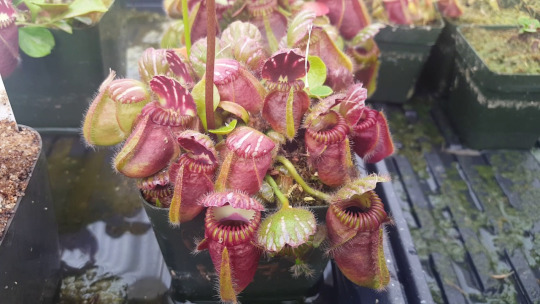
This species comes from a small region in Australia and has a combination of interesting characters discussed earlier. While it may not be quite as bulbous as the Open pitchers, it still has a short and round body compared to the other pitcher plants. C. follicularis also has a covered leaf lid unlike the Open pitcher, despite their visual similarities. And, similarly to the Tropical pitcher plant, it grows at the end of a vine-like structure (as seen in picture 2). This species harbors all of the traits that made the Minecraft pitcher plant unique, apart from its ability to stand upright off of its vine instead of hanging off of it. A few more differences from the Minecraft plant is that its cover leaf is a lot rounder compared to what the pixels show, it has a very ridged lip, and it has a pronounced frontal leaf/ridge down the front of its body. Open pitchers also have this leaf down their pitchers, but they are a little less noticeable. C. follicularis is also the only species within the Cephalotus family, meaning that there is not the same diversity as seen within the Tropical or North American families that could be used to find or generate a plant that is closer to the Minecraft one. It is possible that this species could be a better base for trying to replicate the Minecraft pitcher compared to the others, but a lot of work would still have to be done in order to make something that represents the game species.
#minecraft#pitcher plants#analysis#Can you tell what I'm majoring in#If you guessed plants and biotechnology then you are right#Although I'm focusing on agricultural plants not carnivorous#But they hold a special place in my heart and I will restart my collection once I graduate and have stable housing#This is exactly the type of analysis I love to do. I need more to talk about#I also tried to identify the carnivorous plant species Minegishi uses#Something along those lines is in the progress for a future project
1 note
·
View note
Text

Average un-symbiosed Leafwing.
There are actually two types of leafwings, variants if you will. "Living Gardens" and "Walking Plants". This post is about the Living Garden variant.
At heart, Gardens are just that, gardens. They on average look like sticks or peculiar driftwood, and throughout their life have plants growing on them. It starts young where they have the highest chances of a complete symbiosis with a plant, When a Garden first symbioses with a plant, usually only ever one species of plant for their whole lifetime (things can get messy if there's multiple species on one dragon, the plants basically fighting each other for real-estate on the dragon). Vines and trees are by far the easiest for a Garden to symbiose with, with carnivorous plants being the hardest.
Garden families have traditions of keeping the "Family plant", with each generation either symbiosing with the same plant as their parents or the same general species.
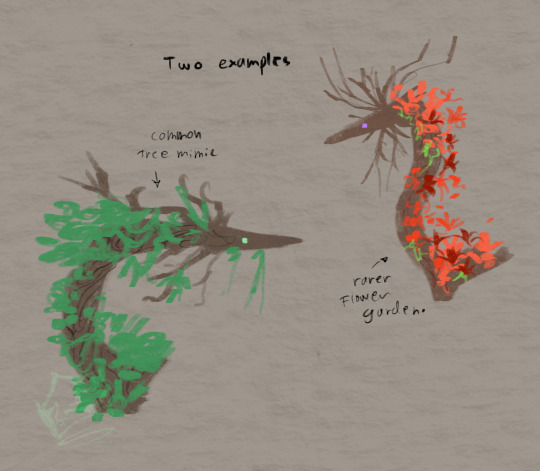
#Hopefully this all makes sense and isn't too convoluted.#I'll make a Walking Plant post later but that one is pretty obvious on what it is.#my art#wof#wings of fire#wof fanart#wof leafwing#leafwing#dragon#dragon art#art#artwork#creature#creature art#[HEADCANONS]
2K notes
·
View notes
Text
Native Plant Info Masterlist...2!
This will be a USA centric post sadly, mostly focused on the East, since I am unfamiliar with resources outside of my area.
iNaturalist lets you upload pictures of any organisms and get them identified by the community, but if you don't want to upload, you can still lurk and look through all the photos being posted in your area to develop familiarity with the plants
Wildflower Search lets you toggle between photos of leaves, flowers, fruits etc. of each plant, gives loads of links to other sites that provide info, lets you search by flower color, plant type, time of year, and about a dozen other search criteria- very cool site
Wildflower.org is another very good site- has a search function where you can search plants by various traits and qualities
Find native plants by the number of butterflies that use them
Butterfly host plant list
Keystone species for every USA ecoregion for butterflies and bees
UNC Chapel Hill's 2022 Flora of the Southeastern United States. The ultimate EXHAUSTIVE compendium of plants. You can download it but beware it is over 2,000 pages long
Illinois Wildflowers is an excellent resource for plants found throughout the southeast and Midwest
Virginia Wildflowers
Northern Forest Atlas Awesome high quality photos of trees and leaves, buds, etc.
Name That Plant is a great resource focused on the Carolinas and Georgia
Maryland Biodiversity has much information on plants and many other creatures
Sarracenia.com is all about carnivorous plants
Native Beeology is focused on native bees of New York State
Also try looking up "[your state] native plant society" as many states have one! It could be a great way to find opportunities to get involved.
#usa centric#native plants#native plant gardening#gardening#plants#nature#flowers#bees#save the bees#no lawns#kill your lawn#fuck lawns#biodiversity#conservation#us centric#trees
2K notes
·
View notes
Text


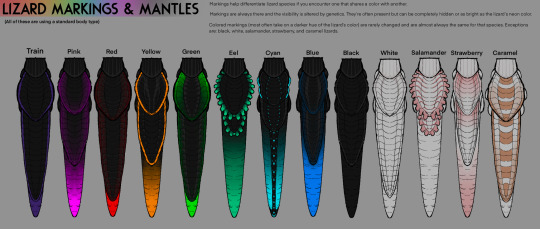

Finally got around to finishing this houugh... it was a lot of work but I really like the end result!! Naturally, I'll try my best to list some of the thoughts I have in mind for these guys below. Long post ahead!
These lizards are intended to be ALMOST fully arthropod-like but due to my lack of understanding of bug anatomy and creative liberties, they are in that gray spec bio area so don't take any inconsistencies too seriously (or rather, fuck logic, and accept them how I describe them regardless)
Inspirations:
- my lesser detailed lizard design
- my friend's slugcats
- wasps for the head contours, various insects for the exoskeleton guidelines, caterpillars, various stylistic slugcats across the #rainworld tag
- the burning need for something more detailed and cool in my drawing vocabulary
The actual meat of the post; extra facts:
- Lizards are related to slugcats (in my au, if you wanna call it that?) or at least the very early version of them. This idea is borrowed from this post and in my au, lizards evolve a similar tail to a slugcat's to aid in propelling themselves through tight spaces, acting as a 5th limb.
- Similar to my old vulture post, lizards share a similar lifecycle. The majority of the larval stage is spent underground and in tight spots, far from their main predator. Lizard larva will undergo pupation similar to how beetles do, leaving behind broken cavities in pipes where carnivorous plants favor to take root. Additionally to the vulture's terrible parental drive, they often mistake their own larva for lizard hatchlings.
- A lizard's skin is leathery and retains moisture for quite a while. Some lizards have a thicker layered mantle than others, allowing them to take punctures to the abdomen and still recover.
- Not pictured, but will be described, are a few outliers to the standard lizard body plan. Caramels have muscular hind legs akin to a grasshopper but this means their legs cannot slot together and thus they have a wider leg splay than other species. Eels and salamanders are not lizards but lizard mimics. Yellow lizards' antennae attach to a hump on the snout rather than the rear of the head as seen here. Cyan lizards' mantles are more square shaped due to their leap drums on either side of their bodies and have a 3rd mantle that runs the length of their tail and caps the tailtip.
- Cyan lizard's organs are called leap drums and act similarly to our lungs. They are a ring of muscle which contracts and acts as a spring loaded mechanism to propel the creature via combustion through a mysterious chemical process. Because the color of debris left behind during a leap share the same color as the lizard, perhaps they are discarded scales, formerly in place to protect the cavities housing the explosion.
- They have similar organs to vertebrates within their abdomen, probably surrounded by cartilage. (not that important, I haven't thought that much about this)
- (More may be added later as I remember)
#myart#rainworld#rainworld lizard#rain world lizard#rw lizard#bug#insect#bugs#insects#rainworldbuilding
2K notes
·
View notes
Text
This is super exciting! Invertebrates are often overlooked in favor of the charismatic megafauna, but in a lot of ways they're even more ecologically crucial. These little native snails are detritivores, helping to break down decaying matter and convert it back to nutrients more accessible to other living beings. The invasive snails that overtook their habitat--the African giant land snail and the rosy wolf snail--don't fulfill the same ecological roles. The former voraciously chows down on live plants, while the latter is a carnivore that hunts down other snails.
It's even more important to be reintroducing the native partula snails, because these species have been declared extinct in the wild. The last few members of each species were brought into captivity and bred in safe enclosures, and now their descendants are heading back to their historic range in places that have had all of their predators removed so they have a good chance of building up a healthy population before spreading out beyond those safe confines.
And to that I say: "Go, little snails, go!"
#snails#nature#invertebrates#animals#molluscs#wildlife#endangered species#extinction#biodiversity#environment#habitat restoration#ecology#conservation
2K notes
·
View notes